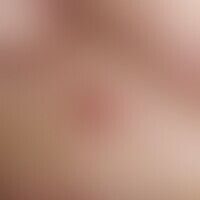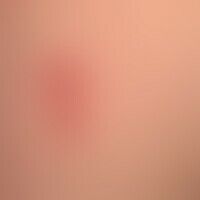Image diagnoses for "Plaque (raised surface > 1cm)", "red"
423 results with 1872 images
Results forPlaque (raised surface > 1cm)red

Seborrheic dermatitis of adults L21.9
Dermatitis, seborrhoeic. 6-month-old female patient with almost symmetrical, blurred, flatly infiltrated, scaly, non-itching red plaques. good clinical response to steroidal pre-treatment. recurrence of skin symptoms within a few days after discontinuation of therapy.

Mycosis fungoides C84.0
Mycosis fungoides: Tumor stage. 53-year-old man with multiple, disseminated, 1.0-5.0 cm large, in places also large-area, moderately itchy, clearly consistency increased, red, rough, eroded plaques. development over 4 years.

Atopic anal dermatitis L20.8
Eczema, anal eczema, atopic dermatitis, chronic ekezmatouschanges of the perianal region with known atopic diathesis.

Larva migrans B76.9
Larva migrans. Characteristic, itchy, linear gait structures on the sole of the foot.

Lupus erythematosus subacute-cutaneous L93.1
lupus erythematosus, subacute-cutaneous: a clinical picture that has existed for several years, varying in severity and severity, no significant feeling of illness; ANA+, anti-Ro Ak+, no dsDNA-Ak.

Erythrokeratodermia figurata variabilis Q82.8

Pityriasis rubra pilaris (adult type) L44.0
Pityriasis rubra pilaris (adult type) Detailed view: chronic recurrent course for years with phases of marked improvement and extensive recurrence (fig. in a thrust period).

Chilblain lupus L93.2
Chilblain lupus. early stage with livid-red, surface smooth, painful plaques. clinical picture reminiscent of chilblain (frostbite lupus). no other systemic signs of lupus erythematosus.

Nodular vasculitis A18.4
erythema induratum. inflammatory, moderately painful, red to brown-red, subcutaneous nodules and plaques. size 2.5 cm, rarely up to 10 cm. often deep-reaching, necrotic melting with subsequent ulceration. chronic course over several years possible. healing with the leaving of brownish scars.

Erysipelas A46
Acute erysipelas. acutely appeared, since a few days existing, increasing, flat, sharply defined, pillow-like raised, flaming red and painful swelling of the cheek and the left eye. distinct impairment of the general condition with fever.

Basal cell carcinoma nodular C44.L
Basal cell carcinoma, solid, sharply defined, slow-growing, approx. 5 mm diameter, smooth, shiny, rough papules.

Tinea pedis (overview) B35.30
Tinea pedum. general view: Discrete, well-defined, heart-shaped, slightly scaly hyperkeratosis and erythema on the right foot back of an 80-year-old female patient with exacerbated tinea pedum.

Dyskeratosis follicularis Q82.8
Dyskeratosis follicularis (Darier's disease) Disseminated, yellow-brownish papules and plaques, sometimes covered with small crusts.

Atopic dermatitis (overview) L20.-
extrinsic atopic dermatitis: eminently chronic, somewhat asymmetrical eczema with blurred, itchy, red, rough, flat plaques. known (only slightly pronounced) rhinoconjunctivitis allergica. I.A. variable course with activity spurts ("overnight"). IgE normal. no atopic FA.

Psoriasis (Übersicht) L40.-
Psoriasis: Plaque type with anular formations. Massive scaling. No pre-treatment.

Fixed drug eruption L27.1
Drug reaction fixed: red, sharply defined, little itchy plaques that have been present for several days; tendency to central blistering.








